The north-west of the republic is home to numerous Shipyards with a worldwide reputation. Civil and military Shipbuilding form a symbiosis.
The coastal states of Lower Saxony and Bremen are traditionally home to an efficient, future-orientated and globally active maritime industry. It is made up of Shipyardssystem providers, component manufacturers, facilities and technical and business services companies. Naval shipbuilding is of particular importance.
Maritime industry on the Weser
Founded in 1875 and based in Bremen-Vegesack, the Fr. Lürssen shipyard with its 2,700 employees is a world-class shipbuilding company in northern Germany. In addition to the headquarters in Bremen-Lemwerder, the Bremen-Aumund and Berne sites and the subsidiaries Lürssen Kröger Werft, Neue Jadewerft, Norderwerft, Peene Werft and Blohm+Voss make the Fr. Lürssen Group a high-performance system house not only for yacht building, but above all for the construction of naval vessels. This means that the company, with its Shipyards Lürssen Logistics has extensive capacities for ship newbuilding, conversions, repairs and retrofits, logistics, training and global maritime services. These services include spare parts supply, refit measures, maintenance, repairs, documentation, training and aftersales services.
The traditional shipyard site in Lemwerder alone, the central location of the ship design department, the training workshop and the central warehouse, offers optimal conditions for the construction of megayachts and naval vessels with several shipbuilding halls, a slip and displacement facility, a 550 metre-long fitting-out pier and a 148,000 square metre production area.
During the First World War, the shipyard built fast torpedo boats. From 1929, the Reichsmarine ordered minesweepers from Lürssen and from 1933 the first diesel-powered speedboats were delivered. Lürssen then developed into the main shipyard for German speedboats and delivered 175 speedboats during the Second World War. From 1954, Lürssen again built the first boats of this type for the young German navy and for the export market. From 1960, Lürssen expanded its portfolio to include the construction of tenders, minehunting boats, coast guard boats, offshore patrol vessels, corvettes and frigates through to the BERLIN-class task force supply vessels. Over the past 65 years, the Lürssen shipyard has designed, built and delivered a total of around 600 naval vessels of all types and classes. The German Navy and the German Navy have received around 240 of these, 195 units have gone to foreign navies and 154 units have been built under licence.
As a member of the F 125 consortium, Lürssen played a key role in the construction of these four new frigates. Lürssen is the lead member of the K 130 consortium and is therefore in a position of responsibility for the construction of the second corvette batch. The KÖLN, the first unit in this series of five, is scheduled for delivery at the end of 2022. In 2021, Lürssen, in cooperation with Neptun Werft in Rostock, a subsidiary of Meyer Werft, was awarded the contract to build two supply vessels as successors to RHÖN and SPESSART. The first supplier is due to be handed over in 2024. Lürssen was also commissioned to build three new fleet service boats in 2021. Their delivery is scheduled to start in 2027.
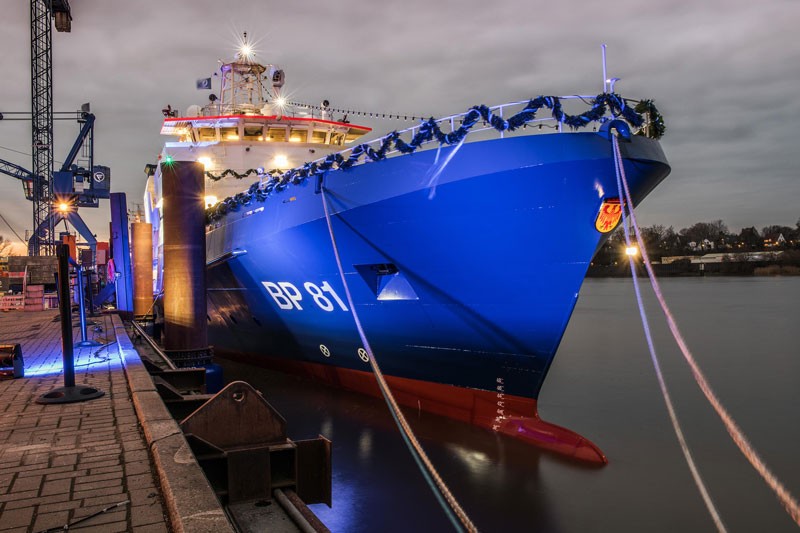
The BP 81 POTSDAM patrol vessel was built at the Fassmer shipyard. Photo: Federal Police
Double hull specialists
The traditional shipyard Abeking & Rasmussen (A&R) in Bremen-Lemwerder with its 490 employees has stood for quality work for over 114 years. Since then, the company has delivered over 6500 sailing and motor yachts, naval and specialised vessels. As early as 1907, ten years after the shipyard was founded, it delivered the first ten minesweepers to the Imperial Navy. Since then, Abeking & Rasmussen has been involved in the design and construction of all building programmes for the German navy's mine countermeasure units.
While minesweepers such as the SCHÜTZE class were made of wood until the 1970s, A&R carried out extensive groundwork with austenitic steel and with regard to the required shock resistance and signature reduction as part of the development of the SM 343 and MJ 332 classes.
As part of the MJ 2000 development project, the suitability of Swath@A&R technology for highly protected units was demonstrated and new approaches for signature reduction and shock resistance of systems and devices were tested. The knowledge gained was continued in our own investigations and tests. The Swath technology (Small Waterplane Area Twin Hull) has already been used to produce over 26 vehicles, including pilot transfer boats and a five-unit series of patrol boats for the Latvian Navy. A major step forward was celebrated in October 2015 with the inauguration of the new shipbuilding hall. A&R is now able to build and equip complex vessels up to 125 metres in length in a weather-protected environment. A&R also intends to continue its endeavours to build mine countermeasures units, as the German Navy and a number of export customers are showing a need for new builds. Compared to the SM 343 and MJ 332, these units will be considerably larger. A&R has prepared for this with the expanded infrastructure and its own initial designs. A 62 metre long minehunting boat is currently being built in Lemwerder for the Indonesian Navy. In addition to mine defence, the shipyard will be working intensively on orders for the construction of naval vessels up to corvette size in the future, including corresponding auxiliary and support vessels.
Founded in 1850 and headquartered in Berne, Fr. Fassmer Werft employs around 1500 people worldwide. The company primarily develops, designs and builds specialised vessels, including research vessels with LNG propulsion, offshore patrol vessels (OPV), ferries with LNG propulsion, explorer yachts, sea rescue boats, fire-fighting boats, police and customs boats as well as special boats for the German Navy and other authorities. These include the OPV 80, which displaces 1850 tonnes and has already been delivered to Chile and Colombia. The 80.60 metre long deep-sea patrol boats are characterised by their exceptionally stable sea behaviour. They have a helicopter landing deck and accommodation for up to 100 people. The sea endurance is 30 days. Fassmer has succeeded in building three operational vessels for the Federal Police Sea on time and on budget in a record time of just two years. The type ship BP 81 POTSDAM was constructed according to the design of the OPV 80 with a modern diesel-electric and environmentally friendly propulsion system. The shipyard has thus set new standards for the construction of government vessels and at the same time cemented the reputation of the German shipbuilding industry as a reliable and innovative partner.
World-class electronics
Atlas Elektronik in Bremen can look back on over 130 years of history. Today, the maritime high-tech company has an international presence with 2100 employees. Since April 2017, it has been a subsidiary of Thyssenkrupp and is a division of Thyssenkrupp Marine Systems (TKMS). The two companies complement each other to form a marine systems house of international calibre with a total of around 5500 employees. Atlas specialises in marine electronics systems. These include sonar and sensor systems, mine hunting systems, autonomous surface and underwater vehicles as well as command and control systems for submarines and surface vessels. The company is the only sonar manufacturer in Germany. The company is the market and technology leader in the fields of hydroacoustics, sensor technology and information technology, making it the preferred supplier to many navies and civilian customers.
Atlas Elektronik generates around 95 per cent of its turnover with military-qualified systems and products. The company's civilian business is primarily in electronic components, with Airbus' civil aircraft division being the main customer. The company holds over 5,000 patents and invests five per cent of its annual turnover in research and development.
The German government has declared the company's capabilities and technologies to be national key technologies and anchored them in a security agreement. This makes Atlas Elektronik a strategic defence technology company.
The company is increasingly working on the development of unmanned underwater and surface vehicles for the military and civilian market. Current naval programmes include the command and weapon deployment system for frigates 125 in close cooperation with TKMS. For the Class 124 frigates, it is consortium leader of a team with Thales for the hardware regeneration of the command and control system, and modernised the Class 332 minesweepers as prime contractor. In submarine construction, Atlas is a traditional supplier of state-of-the-art sonars including the associated systems for signal processing and situational awareness. The product portfolio also includes the DM 2 A4 heavyweight torpedo and its export variant SeaHake mod 4. The company is currently preparing for close strategic co-operation with Kongsberg as part of the German-Norwegian U 212CD procurement project. Series production of the first SeaSpider anti-torpedo torpedo has also begun. This technologically leading hard-kill solution against torpedoes is being offered for the first time worldwide. By integrating state-of-the-art sonar systems for surface and underwater vessels, the SeaSpider will be supplemented to form an integrated torpedo defence system. Atlas Elektronik generates around 60 per cent of its turnover from exports. However, the German procurement authority, and therefore also the German Navy, will continue to be the most important customer in the future.
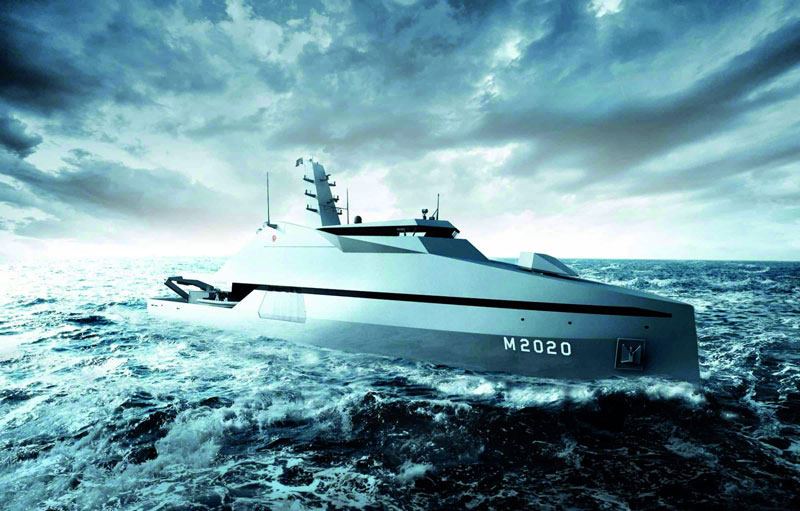
Design of the futuristic minehunting boat Apex Protector from A&R. Graphic: A&R
Shipyard with history
Lloyd Werft stands for over 160 years of shipbuilding tradition in Bremerhaven. It has two dry docks and one floating dock, a 1400 metre-long pier and numerous cranes and workshops. The company has 350 employees and can handle ships up to 300 metres long and 11 metres deep in the docks. It specialises in repairs, conversions and modernisations through to interior fittings and prefabricated buildings. During the First World War, the shipyard produced mine and torpedo net barrages, converted the passenger ships KAISER WILHELM DER GROßE and BERLIN into auxiliary cruisers with heavy guns, turned steamships into hospital ships or fishing steamers into outpost boats. The large Kaiserdock was converted into a submarine base. During the Second World War, Lloyd Werft again converted fishing trawlers into patrol boats and used its docks to repair destroyers, tankers and barrier breakers. The battleship GNEISENAU was repaired here after being hit by a mine. Today, Lloyd Werft optimises all ship types with up to 110,000 GT. The German Navy has been a customer of the shipyard for many decades. In particular, frigates are repaired there. In recent years, this has included the SCHLESWIG-HOLSTEIN, the MECKLENBURG-VORPOMMERN and the LÜBECK. The shipyard, which has belonged to the Asian Genting Group since 2015, is currently facing possible closure due to the coronavirus pandemic and the slump in the cruise industry. However, the parent company is working on a future strategy to save the shipyard.
The former Nordseewerke Emden have a long history. Shipbuilding-tradition. They were founded in 1913 and changed hands several times. In 1974, it became part of the Group subsidiary Thyssenkrupp Marine Systems, which sold the shipyard in 2010 to Schaaf Industrie AG (Siag Group), which became insolvent in 2012. The shipyard now belongs to the Norwegian shipbuilder Fosen Yard. Nordseewerke was active in the fields of naval shipbuilding, merchant shipbuilding and ship repair until 2011. During the First and Second World Wars, they built submarines, minesweepers and outpost boats for the German Imperial Navy and Kriegsmarine. Between 1941 and 1944, over 30 submarines of types VII C and VII C/41 were launched. After the Second World War, the Allied Control Council authorised the construction of fishing trawlers and later the construction of general cargo and bulk carriers. From 1951, the company specialised in the construction of submarines, building ten submarines for the German Navy, 15 submarines of the KOBBEN and ULA class for Norway and two TR 1700 submarines for Argentina.
Nordseewerke was also involved in the construction of the class 206 and 212A submarines and the DOLPHIN class submarines for Israel. In 1980, the keel of the frigate EMDEN was laid in Emden, and the frigates BAYERN and HESSEN were also launched there. Finally, the research vessel PLANET was built for WTD 71 in 2004, and the task force supply ship BONN was completed in Emden in 2011.

Firing start of the corvette Köln 2019 in Bremen, the start button is pressed by the then Defence Minister Ursula von der Leyen, Friedrich Lürssen and the then Inspector of the Navy, Vice Admiral Andreas Krause. Photo: PIZ/M Brakensiek
Losers of the pandemic
With 3800 employees, Meyer Werft in Papenburg is one of the largest and most modern shipyards in the world. Shipyards in the world. Meyer Werft also owns the Neptun shipyard in Rostock and Meyer Turku in Finland. State-of-the-art cruise ships for international shipping companies have been built in Papenburg in particular for decades. This includes the ODYSSEY OF THE SEAS. The ship is 347 metres long and can accommodate 4248 passengers. She is the fifth and last ship in the QUANTUM class that the American shipping company Royal Caribbean ordered from Meyer Werft. To date, around 50 luxury liners have left the shipyard. The first cruise ship to be powered by low-emission liquefied natural gas (LNG) was delivered in 2018.
Today, Meyer Werft is recognised as a technology leader in cruise ship construction. The shipyard also builds river cruise ships and ferries. The cruise industry in particular has been hit hard by the coronavirus pandemic. As a result, there has been hardly any demand for new cruise ships since 2020. The virtual cancellation of tourism business in the first year of the pandemic has hit Meyer Werft correspondingly hard. Added to this is the competition with shipbuilders from the Far East, increasingly from China. Meyer Werft is therefore currently in a crisis. Short-time working and job cuts characterise the shipyard's operations. The order book shows no more new orders from 2023. Bernhard Meyer, Managing Director of Meyer Werft, said: "We are still going through the biggest existential crisis I have ever seen in the shipyard. Shipbuilding have experienced." Nevertheless, he hopes that demand for cruise ships will grow again once the coronavirus pandemic has been overcome.
Author: Dieter Stockfisch


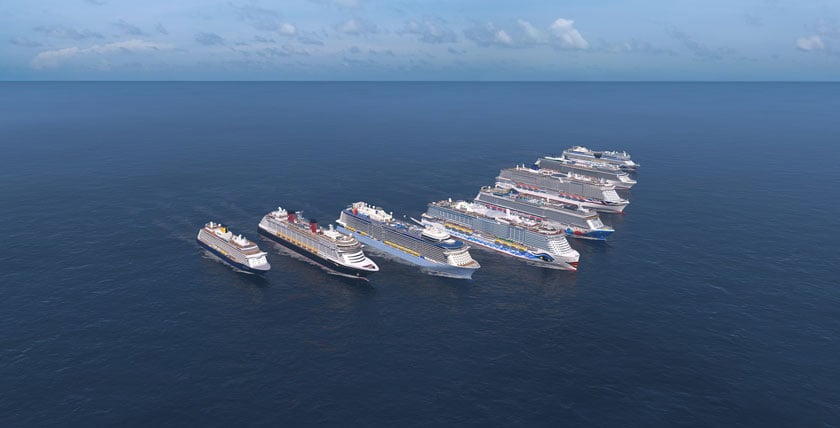







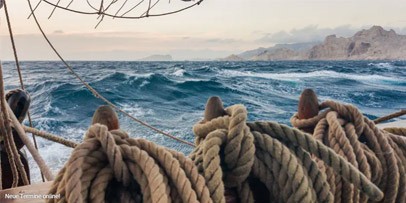

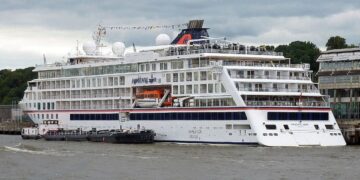
0 Kommentare